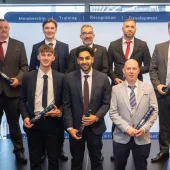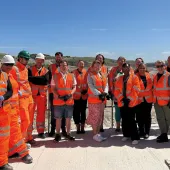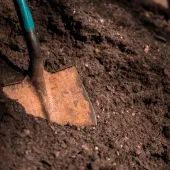A Look Back in Time

A brief history of The Institute of Quarrying offices and officers: 1917–2012
By Jack Berridge, managing director, QMJ Publishing Ltd
The adjacent portrait of Simon McPherson in his later years was painted by the royal portrait painter Simon Elwes. It was a gift to him from the Institute of Quarying (IQ) and, after his death, was given back to IQ by his family, since when it has hung in the office.
Originally from Aberdeen, Simon McPherson, or ‘Mac’ as he was universally known, was a stonemason who had come to Wales to work on the Elan Valley Dam project and subsequently managed Tyddyn Hywel and Tan y Graig quarries, south of Caernarfon, between 1909 and 1922.
On 17 October 1917, he met up with four local quarry managers at the Price of Wales Hotel in Caernarfon to discuss the idea of starting an association of quarry managers.
With the support of his chairman, Henry Grace of the The Enderby Company, at this meeting it was agreed that Simon McPherson would take on the role of Honorary Secretary and his first duty was to invite all quarry managers in North Wales to a meeting which took place at the Sportmans’ Club in Portmadoc on 3 November.
Although the attendance of seven was disappointing, those present decided to press on with the formation of ‘The Quarry Managers’ Association’ and the first task was to formulate the aims and objectives of the new organization.
On 1 December 1917, a meeting was held with local quarry owners to allay any fears that their intention was to form a trade union for quarry managers and, on 12 January 1918, the first Annual General Meeting was held in Caernarfon.
Unfortunately, due to the restricted train service in operation during the war, only three of the 19 members managed to attend. Nevertheless, a management committee was formed and the objects of the Association were defined as: ‘The discussion of technical and geological questions relating to quarrying and other matters relating to the control and welfare of quarries’.
During the first year membership grew very slowly and by the autumn Simon McPherson became convinced that regular publicity was needed to ensure the survival of the Association. Accordingly, he set about producing the first issue of The Quarry Managers’ Journal, which was published on 5 November 1918. It is interesting to note that the publication date of the Journal has never changed and it has now been published on the fifth of the month for some 94 years!
The launch of the Journal proved to be the turning point in the fortunes of the Association and by the end of 1919 membership had risen to around 150. In that year brigadier general Sir Henry Mayberry, the influential Director of Works at the Ministry of Transport, accepted an invitation to become the first President.
In 1920 the Association’s name was changed to ‘The Institution of Quarry Managers’ and the first conference took place the following year. In May 1924 the Journal was formed into a limited company and Simon McPherson took on a full-time role as general secretary of the Institution and editor of QMJ.
In January 1925 the office was moved from its original base at Barclay’s Bank Chambers in Caernarfon to a more central location at 160 Edmund Street in ‰ Birmingham, and three years later it was moved across the city centre to 53 Broad Street.
The name of the organization was changed again in 1927 to ‘The Institute of Quarrying’ and the first lady member, Mrs Anne Greaves, was admitted into membership. In 1933 the office moved from Birmingham to Salisbury Square, off Fleet Street in central London, which Simon McPherson thought was the right place for a publishing business to be based.
During the war, however, the Salisbury Square office suffered bomb damage and in September 1940 Simon McPherson and his staff were evacuated to the safety of Cornwall, where a temporary office, made available by a local quarry owner, was set up in a disused railway carriage at Trevillett, near Tintagel.
In June 1943 Simon McPherson and his staff returned to Salisbury Square which, by this time, had been rebuilt. At the end of the war the operation of IQ and QMJ returned to normal until, in 1957, Mac died aged 80 and still in office. He was succeeded as General Secretary of IQ and managing director of QMJ by his son John, who had trained as a journalist and taken over from his father as editor of the Journal and Cement, Lime and Gravel on his return to the business from wartime service with the London Scottish Regiment.
In 1958 the Institute’s familiar coat of arms was adopted. Designed at the College of Arms in London by the ‘Richmond Herald’, Anthony R. Wagner, the arms were a gift from the outgoing President, Hugh Symington of Springbank Quarry Company, to mark the incorporation of the Institute as a company limited by guarantee.
The ‘armorial bearings’ are meant to symbolize the origin, aims and scope of the Institute, and the three heraldic components of the coat of arms are the shield, the crest and the motto.
The shield is comprised of two ‘jads’, or hammers, representing the ancient tools of the trade, and the coronet between them is adorned with wattle flowers (left, centre and right) to represent the section in Australia with trefoils in between for Wales. On top of the shield is the crest in the form of a quarry face with green-topped overburden surmounted by a lion to represent the Scottish branch, and in its paws is a key symbolizing knowledge and freedom.
The octagonal stone tower with two turrets represents the castle at Caernarfon, the Institute’s birthplace, where the designer’s inspiration was clearly drawn from the Eagle Tower which overlooks the Menai Straits on the western flank of the castle.
The motto ‘Terram Autem Filiis Hominum’ is a passage taken from Psalm 115, which translates as ‘The earth he hath given to the children of men’ and originated from a competition promoted in the Journal to find a suitable motto for the Institute.
Unfortunately, in 1960, less than three years after the death of his father, John McPherson died at the age of 46. On 1 February 1961 Brian Fish took over as technical officer of the Institute and editor of QMJ, and in the same year the IQ and QMJ office moved to new premises at 62–64 Baker Street, London.
The office remained at Baker Street for 13 years until August 1974 when, because of spiralling rents in the West End of London, it was decided to move to the more geographically central and lower-cost location of Nottingham.
After 24 years of service, Brian Fish retired in November 1984 and Jack Berridge took over responsibility for running both organizations. This arrangement lasted for almost 28 years until it was decided to set up a new education and training centre for the minerals industry at a business park on the outskirts of Nottingham, with Phil James joining as executive director of both the Institute and its sister organization, the Minerals Products Qualifications Council.








